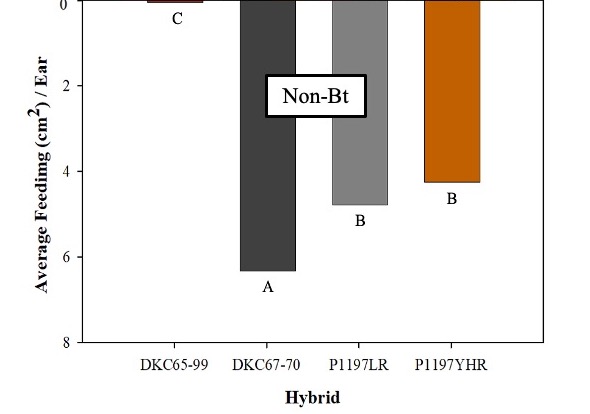Maximizing Corn Yields: Bt vs Non-Bt Hybrids in Statewide Large-Plot Trials
go.ncsu.edu/readext?1025803
en Español / em Português
El inglés es el idioma de control de esta página. En la medida en que haya algún conflicto entre la traducción al inglés y la traducción, el inglés prevalece.
Al hacer clic en el enlace de traducción se activa un servicio de traducción gratuito para convertir la página al español. Al igual que con cualquier traducción por Internet, la conversión no es sensible al contexto y puede que no traduzca el texto en su significado original. NC State Extension no garantiza la exactitud del texto traducido. Por favor, tenga en cuenta que algunas aplicaciones y/o servicios pueden no funcionar como se espera cuando se traducen.
Português
Inglês é o idioma de controle desta página. Na medida que haja algum conflito entre o texto original em Inglês e a tradução, o Inglês prevalece.
Ao clicar no link de tradução, um serviço gratuito de tradução será ativado para converter a página para o Português. Como em qualquer tradução pela internet, a conversão não é sensivel ao contexto e pode não ocorrer a tradução para o significado orginal. O serviço de Extensão da Carolina do Norte (NC State Extension) não garante a exatidão do texto traduzido. Por favor, observe que algumas funções ou serviços podem não funcionar como esperado após a tradução.
English
English is the controlling language of this page. To the extent there is any conflict between the English text and the translation, English controls.
Clicking on the translation link activates a free translation service to convert the page to Spanish. As with any Internet translation, the conversion is not context-sensitive and may not translate the text to its original meaning. NC State Extension does not guarantee the accuracy of the translated text. Please note that some applications and/or services may not function as expected when translated.
Collapse ▲Bt corn growers are required to plant 20% of their total corn acres to non-Bt corn for resistance management. An important question is do growers lose yield on the 20% of the acres they plant to non-Bt corn? In addition, recent economic analysis from Georgia indicated that growers pay an average of $14 to 28 more for Bt hybrids than non-Bt hybrids. If growers lose yield planting non-Bt corn will the seed savings offset potential losses?
Previous work in the state has focused on small-plots comparing non-Bt hybrids and Bt hybrids at the Tidewater Research station in Plymouth, at research stations in North Carolina, South Carolina and Georgia (results published soon!), and in the OVTs. Across these trials we found that timely planted Bt and non-Bt hybrids from similar genetic backgrounds yield the same. In contrast there is a slight yield penalty to planting a non-Bt corn hybrid when it is planted beyond the last recommended planting date.
Therefore, according to data from 3 sets of multi-year experiments, growers who select a high-yielding non-Bt hybrid and plant it on time, will not lose yield compared to if they planted a Bt hybrid. But what if we put this into the hands of growers? How would non-Bt hybrids stack up?
Graduate student Alexis Alsdorf, recently collaborated with NCCE county agents across the state to test the efficacy and yield of non-Bt hybrids and Bt hybrids in large plot trials. We chose a non-Bt and Bt hybrid pair from both Dekalb and Pioneer. These were planted, maintained, and harvested on grower farms using grower equipment during 2022 and 2023 in 55 total fields spread across North Carolina from the mountains to the sea.
Bt hybrid efficacy was as expected. Feeding was mainly by corn earworm and was equal between both years. The hybrid expressing Cry and Vip Bt traits (DKC65-99) had very little feeding by corn earworm, the hybrid expressing Cry Bt traits (P1197YHR) and its’ non-Bt pair (P1197LR) had moderate feeding, while the non-Bt hybrid DKC67-70 had the most feeding. Note that corn earworm is resistant to the Cry Bt traits.
However, yields did not follow feeding patterns. Results were different between years, with yields tending to be higher in 2023. Importantly, yields were equal between non-Bt and Bt hybrid pairs in each year. DKC65-99 and DKC67-70 yielded the same in both 2023 and 2022. Similarly, P1197YHR and P1197LR yielded the same in both 2023 and 2022.
This matched the results from the 3 sets of multi-year experiments in small plots. Growers who select a high-yielding non-Bt hybrid and plant it on time, will not lose yield compared to if they planted a Bt hybrid. In fact, they could save on seed costs on the 20% of acres they planted to non-Bt.
We encourage growers to work with their corn seed provider to select appropriate high-yielding non-Bt hybrids for their 20% refuge acres.




